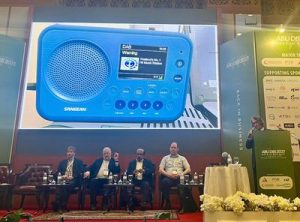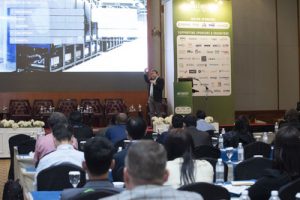
On the first day of the Asia-Pacific Broadcasting Union (ABU) Digital Broadcasting Symposium, over 150 delegates attended the WorldDAB workshop: “Economics, Environment, Emergency – driving the case for DAB+.”
WorldDAB Project Director Bernie O’Neill updated the audience on the platform’s global growth, noting that DAB+ was now well established and growing in Australia, with Asia Pacific markets continuing to run trials, and a step change in interest from Africa and the Middle East. Along with continued development and innovation in more established DAB+ markets, “deployment of DAB+ in Asia Pacific, Africa and the Middle East is a priority,” O’Neill told delegates.
DAB’s Service Programme Information feature was growing in importance, said Lindsay Cornell, Chair of WorldDAB’s Technical Committee, who announced the creation of a Task Force to update the specification to make aspects easier to interpret, and to include new XML features relevant to broadcast.
Cornell also noted that the receiver testing ETSI standard had been updated with extra requirements to make it suited to a much wider geographical area. It will now incorporate tests that ensure delivery of non-Latin text to suitable displays, including EBU Latin, All Europe, ASBU, Thai, and Greek and Cyrillic characters.
Chair of WorldDAB’s APAC Technical Group, Les Sabel, updated the audience on DAB+ developments in the region. He noted trials in Thailand, including functional testing, outdoor and indoor field testing, supported by education and training. In Bangkok, the trial broadcast 18 audio and one data service, with a 10 kW ERP central Bangkok transmission site. Other trials were focussed on four regional areas and centres: Chon Buri, Chiang Mai, Khon Kaen and Song Khla.
Sabel also spoke about the development of small-scale DAB, which he described as “essential” in helping community radio stations to participate in digital radio’s future. This often uses open-source software and SDR solutions for support systems, and it was “being increasingly valued and added to countries’ regulation frameworks,” Sabel said.
Continuing the small-scale DAB theme, “think differently, work locally,” was the advice from Nick Piggott of Bristol Digital Radio, a multiplex operator in the west of England. “We’ve built a minimum viable product – a saloon car, not a luxury vehicle,” he said. “DAB can be done very cost-effectively without disrupting the existing ecosystem to make the most of the opportunity.”
Lars-Peder Lundgren, CEO of Paneda Sweden, spoke about emergency warnings on DAB, noting the robustness of broadcast networks. “There have been many cases where mobile networks and internet were down, but never DAB,” he said. “In some situations, mobile networks are shut down on purpose. Broadcast networks are most reliable, with 99.9% uptime as a minimum.”
broadcast networks. “There have been many cases where mobile networks and internet were down, but never DAB,” he said. “In some situations, mobile networks are shut down on purpose. Broadcast networks are most reliable, with 99.9% uptime as a minimum.”
Innovations in transmitters were the focus of a session from Oscar Hu, Regional Sales Manager, Southeast Asia, GatesAir. Last year, the company launched the first self-contained, fully weatherproof transmitter series, built for challenging coverage areas and unusual install points.
Finally, the ease of a modern DAB roll-out was highlighted by Hermann Zensen, Head of Sales and Marketing, Digidia. Modern DAB head ends are completely software and IP based and therefore compact, easy to install and maintain, even remotely. This means it is possible to start cost-efficient trial systems very quickly, Zensen said.
This story first appeared on RadioInfo.asia
